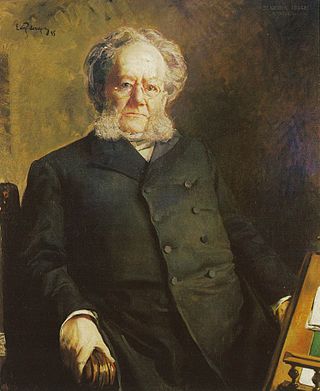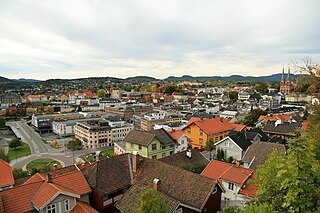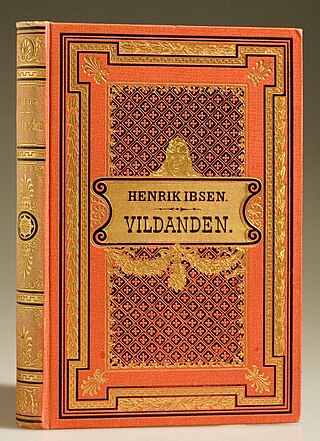
A Doll's House is a three-act play written by Norwegian playwright Henrik Ibsen. It premiered at the Royal Danish Theatre in Copenhagen, Denmark, on 21 December 1879, having been published earlier that month. The play is set in a Norwegian town c. 1879.

Henrik Johan Ibsen was a Norwegian playwright and theatre director. As one of the founders of modernism in theatre, Ibsen is often referred to as "the father of realism" and the most influential playwright of the 19th century, as well of one of the most influential playwrights in Western literature more generally. His major works include Brand, Peer Gynt, Emperor and Galilean, A Doll's House, Ghosts, An Enemy of the People, The Wild Duck, Rosmersholm, Hedda Gabler, The Master Builder, and When We Dead Awaken. Ibsen is the most frequently performed dramatist in the world after Shakespeare, and A Doll's House was the world's most performed play in 2006.

Skien is a municipality in Telemark county, Norway. It is located in the traditional district of Grenland, although historically it belonged to Grenmar/Skiensfjorden, while Grenland referred the Norsjø area and Bø. The administrative centre of the municipality is the city of Skien, which is also the administrative centre of the whole county. Some of the notable villages in the municipality include Åfoss, Hoppestad, Klovholt, Luksefjell, Melum, Kilebygda, Skotfoss, Sneltvedt, and Valebø.

Hedda Gabler is a play written by Norwegian playwright Henrik Ibsen. The world premiere was staged on 31 January 1891 at the Residenztheater in Munich. Ibsen himself was in attendance, although he remained back-stage. The play has been canonized as a masterpiece within the genres of literary realism, nineteenth century theatre, and world drama. Ibsen mainly wrote realistic plays until his forays into modern drama. Hedda Gabler dramatizes the experiences of the title character, Hedda, the daughter of a general, who is trapped in a marriage and a house that she does not want. Overall, the title character for Hedda Gabler is considered one of the great dramatic roles in theater. The year following its publication, the play received negative feedback and reviews. Hedda Gabler has been described as a female variation of Hamlet.

The Paus family is a prominent Norwegian family with a long history of involvement in the clergy and governance elite, nobility, industry, and the arts. The family first emerged as members of the elite of 16th-century Oslo and, for centuries, belonged to Norway's "aristocracy of officials," especially in the clergy and legal professions in Upper Telemark. Later generations became involved in shipping, steel, and banking, establishing themselves as steel magnates in Christiania (Oslo) during the Second Industrial Revolution. The family's most famous members are playwright Henrik Ibsen and singer Ole Paus.

An Enemy of the People is an 1882 play by Norwegian playwright Henrik Ibsen that delves into the conflict between personal integrity and societal norms. The play centers on Dr. Thomas Stockmann, who discovers a serious contamination issue in his town's new spas, endangering public health. His courageous decision to expose this truth brings severe backlash from local leaders, including his brother Peter Stockmann, who is a powerful political figure in the town.

Peer Gynt is a five-act play in verse written in 1867 by the Norwegian dramatist Henrik Ibsen. It is one of Ibsen's best known and most widely performed plays.

Ghosts is a play by the Norwegian playwright Henrik Ibsen. It was written in Danish and published in 1881, and first staged in 1882 in Chicago, Illinois, US, performed in Danish.

The Wild Duck is an 1884 play by the Norwegian playwright Henrik Ibsen. It explores the complexities of truth and illusion through the story of a family torn apart by secrets and the intrusion of an idealistic outsider. It focuses on the Ekdal family, whose fragile peace is shattered by Gregers Werle, an idealist who insists on exposing hidden truths, leading to tragic consequences. The play was written in a realistic style, but literary scholars have pointed out the play's kinship with symbolism. It blends themes such as deception, betrayal, and the disillusionment of modern life with moments of comedy and satire, and is considered the first modern masterpiece in the genre of tragicomedy. The Wild Duck and Rosmersholm are "often to be observed in the critics' estimates vying with each other as rivals for the top place among Ibsen's works".

The Master Builder is a play by Norwegian playwright Henrik Ibsen.

Terje Vigen is a poem written by Norwegian writer Henrik Ibsen and published in 1862. It follows the life of Terje Vigen, a fictional Norwegian man who lives in the town of Grimstad, during the early 19th century. During the Gunboat War, Grimstad is under a British naval blockade, and Vigen decides to travel to Denmark to acquire essential goods for his family in a small rowboat in 1809. However, his boat is captured by a Royal Navy corvette, and Vigen is sent as a prisoner of war to England, where he remains until the war is over. Returning to Grimstad in a Swedish Navy frigate in 1814, Vigen discovers that his wife and daughter have died. Becoming a maritime pilot, years later Vigen rescues a yacht in distress. He discovers that the yacht's captain was the commander of the corvette who took him prisoner, but decides against vengeance and rescues the Englishman along with his wife and child.

Rosmersholm is an 1886 play written by Norwegian playwright Henrik Ibsen. It tells the story of Johannes Rosmer, an aristocratic former clergyman and owner of the Rosmersholm manor who is haunted by his wife's suicide and his own idealistic desires for societal reform, and Rebecca West, a strong-willed companion who challenges his convictions, leading to a deep exploration of morality, political activism, and the struggle for personal and social change amidst a backdrop of intense personal and political turmoil. Rosmersholm has been described as one of Ibsen's darkest, most complex, subtle, beautiful, mystical, multilayered and ambiguous plays. The play explores the tension between old and new, between liberation and servitude, between narratives, action or inaction, and of "what to do with ourselves when the world collapses around us." Rosmersholm and The Wild Duck are "often to be observed in the critics' estimates vying with each other as rivals for the top place among Ibsen's works."
Catiline or Catilina was Henrik Ibsen's first play. It was written during winter 1848–49 and first performed under Ibsen's name on 3 December 1881 at the Nya Teatern, Stockholm, Sweden. The first performance of Catilina in Norway not under Ibsen's pseudonym was at Det Nye Teater in Oslo on 24 August 1935.
A/S Aero was a Norwegian airline company founded by Tancred Ibsen in January 1920. The company was financed by Tancred Ibsen's uncle, businessman Einar Bjørnson, and two shipowners. Despite the A/S in its name, A/S Aero was never formally registered as a limited company.

The International Ibsen Award honours an individual, institution or organization that has brought new artistic dimensions to the world of drama or theater. The committee consists of figures in the theatre community.
Lake Ibsen Township is a civil township in Benson County, North Dakota, United States. As of the 2000 census, its population was 39. It is named for the nearby Lake Ibsen, named by Norwegian settlers after playwright Henrik Ibsen.

MS Henrik Ibsen is a historic Norwegian diesel-powered ship built in 1907. Together with MS Victoria, it sails on the Telemark Canal in Norway between Skien and Dalen in the summer. The ship was built by Eriksbergs Mekaniska Verkstad in Gothenburg, Sweden in 1907 and named SS Styrsö. The ship was operated in the Gothenburg archipelago until 1970, and after that she was used as charter ship. It is named after Henrik Ibsen.

The Théâtre de Paris is a theatre located at 15, rue Blanche in the 9th arrondissement of Paris. It includes a second smaller venue, the Petit Théâtre de Paris.
The Ibsen Year was the Norwegian government's official celebration of Henrik Ibsen in 2006, marking the 100th anniversary of his death. The Ibsen Year included cultural events in multiple countries, including an opening ceremony in Oslo attended by the royal family and international guests, television programs, cultural events in Italy, Germany, the United Kingdom, the United States, China and other countries, and an International Gala performance at the Great Pyramid of Giza in Egypt, hosted by the country's First Lady Suzanne Mubarak and also attended by Queen Sonja. The Ibsen Year's artistic director was Bentein Baardson and the producer was Nora Ibsen. The chairman of the supervisory committee was former Norwegian Minister of Culture Lars Roar Langslet. The planning committee of the Ibsen Year had a core budget of around 70 million NOK, not counting TV productions and various other costs.
Modernist theatre was part of twentieth-century theatre relating to the art and philosophy of modernism.
















